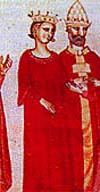Isabella II of Jerusalem
| Yolande/Isabella II | |
|---|---|
 The death of Queen Isabella-Yolande (From MS of William of Tyre's Historia and Old French Continuation, painted in Acre, 13C. Bib. Nat. Française) | |
| Queen of Jerusalem | |
| Reign | 1212 – 25 April 1228 |
| Predecessor | John and Maria |
| Successor | Conrad II |
| Holy Roman Empress; Queen consort of Sicily | |
| Tenure | 1225 – 25 April 1228 |
| Born | c. 1212 |
| Died | April 25, 1228 (aged 15–16) Andria, Italy |
| Burial | |
| Spouse | Frederick II, Holy Roman Emperor |
| Issue | Conrad II of Jerusalem |
| House | House of Brienne |
| Father | John of Brienne |
| Mother | Maria of Montferrat |
Isabella II (1212 – 25 April 1228) also known as Yolande of Brienne, was a princess of French origin who became monarch of Jerusalem.
Infant Queen
Isabella II was born in Andria, in the southern Italian Kingdom of Sicily. She was the only child of Maria of Montferrat, Queen of Jerusalem, and John of Brienne. Maria was the daughter of Queen Isabella I of Jerusalem by her second husband Conrad I, and heiress, on her mother's death, of the Kingdom of Jerusalem.
Maria died shortly after giving birth to Isabella II in 1212, possibly by puerperal fever. Because of this, Isabella II was proclaimed Queen of Jerusalem when she was only a few days old. Because her father John did not have a direct claim on the throne, he ruled as regent.
Marriage with Frederick II

Frederick II, King of Germany and Sicily, had involved himself broadly in the Fifth Crusade, sending troops from Germany, but he failed to accompany the army directly, despite the encouragement of the Popes Honorius III and later Gregory IX, as he needed to consolidate his position in Germany and Italy before embarking on a crusade. However, Frederick again promised to go on a Crusade after his coronation as Holy Roman Emperor in 1220 by Honorius III.
During a meeting between John of Brienne, the Pope Honorius III and Frederick II in the city of Ferentino in 1223, Yolande's fate was decided: Frederick accepted to finally go to the Crusade, but only as the legitimate King of Jerusalem, and this was only possible if he agreed to take the young Queen Isabella II as his wife (by this time, Frederick was a widower). This was planned by the Pope, who hoped by this bond to attach the Emperor firmly to the Sixth Crusade. The betrothal was confirmed, but the Emperor still delayed his departure until August 1225, when he and Isabella were married by proxy in the City of Acre.[1] Days after, Isabella II was crowned as Queen of Jerusalem.
The now crowned Queen arrived in Italy with twenty galleys sent by Frederick II to bring her with her father[2] and married in person to Frederick II in the cathedral of Brindisi, on 9 November 1225. In the ceremony, he declared himself King of Jerusalem and immediately saw to it that his new father-in-law John of Brienne, the current regent of Jerusalem, was dispossessed and his rights transferred to him. The contemporary chronicles described the exotic wedding celebrations, which took place in the Castle of Oria,[3] and the indignant reaction of her father John of Brienne, now without royal authority.
Despite his new capacity as King of Jerusalem, Frederick II continued to take his time in setting off, and in 1227, he was excommunicated by Pope Gregory IX for failing to honour his crusading pledge.
Death
After the wedding, Isabella was kept in seclusion by her husband. She spent her time in Frederick's harem in Palermo. In November 1226, she gave birth to her first child, a daughter (referred to by some sources as Margaret); the baby died in August 1227. Frederick finally sailed from Brindisi on 8 September 1227 for Jerusalem but fell ill at Otranto, where Louis IV, Landgrave of Thuringia, had been put ashore. Frederick postponed the journey while he recovered. In the meantime Isabella died after giving birth to her second child, a son, Conrad, in Andria, Bari, on 25 April 1228.[4] She is buried in Andria Cathedral. Frederick finally embarked to Jerusalem on 28 June.
Although he crowned himself as King of Jerusalem in the Church of the Holy Sepulchre on 18 March 1229, he ruled as regent on behalf of his son, settling a truce with the Muslims in 1229 during the Sixth Crusade.
Ancestry
| Family of Isabella II of Jerusalem | ||||||||||||||||||||||||||||||||||||||||||||||||||||||||||||||||||||||||||||||||||||||||||||||||||||||||||||||||||||||||||||||||||||||||||||||||||||||||||||||||||||||||||||||||||||||||||||||||||||||||||||||||||||||||||||||||||||||||||||||||||||||||||||||||||||||||||||||||||||||||||||||||||||||||||||||||||||||||||||||||||||||||||||||||||||||||||||||||||||||||||||||||||||||||||||||||||||||||||||||||||||||||||||||||||||||||||||||||||||||||||||||||||||||||||||||||||||||||||||||||||||||||||||||||||||||||||||||||||||||||||||||||||||||||||||||||||||||||||||||||||||||||||||||||||||||||||||||||
|---|---|---|---|---|---|---|---|---|---|---|---|---|---|---|---|---|---|---|---|---|---|---|---|---|---|---|---|---|---|---|---|---|---|---|---|---|---|---|---|---|---|---|---|---|---|---|---|---|---|---|---|---|---|---|---|---|---|---|---|---|---|---|---|---|---|---|---|---|---|---|---|---|---|---|---|---|---|---|---|---|---|---|---|---|---|---|---|---|---|---|---|---|---|---|---|---|---|---|---|---|---|---|---|---|---|---|---|---|---|---|---|---|---|---|---|---|---|---|---|---|---|---|---|---|---|---|---|---|---|---|---|---|---|---|---|---|---|---|---|---|---|---|---|---|---|---|---|---|---|---|---|---|---|---|---|---|---|---|---|---|---|---|---|---|---|---|---|---|---|---|---|---|---|---|---|---|---|---|---|---|---|---|---|---|---|---|---|---|---|---|---|---|---|---|---|---|---|---|---|---|---|---|---|---|---|---|---|---|---|---|---|---|---|---|---|---|---|---|---|---|---|---|---|---|---|---|---|---|---|---|---|---|---|---|---|---|---|---|---|---|---|---|---|---|---|---|---|---|---|---|---|---|---|---|---|---|---|---|---|---|---|---|---|---|---|---|---|---|---|---|---|---|---|---|---|---|---|---|---|---|---|---|---|---|---|---|---|---|---|---|---|---|---|---|---|---|---|---|---|---|---|---|---|---|---|---|---|---|---|---|---|---|---|---|---|---|---|---|---|---|---|---|---|---|---|---|---|---|---|---|---|---|---|---|---|---|---|---|---|---|---|---|---|---|---|---|---|---|---|---|---|---|---|---|---|---|---|---|---|---|---|---|---|---|---|---|---|---|---|---|---|---|---|---|---|---|---|---|---|---|---|---|---|---|---|---|---|---|---|---|---|---|---|---|---|---|---|---|---|---|---|---|---|---|---|---|---|---|---|---|---|---|---|---|---|---|---|---|---|---|---|---|---|---|---|---|---|---|---|---|---|---|---|---|---|---|---|---|---|---|---|---|---|---|---|---|---|---|---|---|---|---|---|---|---|---|---|---|---|---|---|---|---|---|---|---|---|---|---|---|---|---|---|---|---|---|---|---|---|---|---|---|---|---|---|---|---|---|---|---|---|---|---|---|---|---|---|---|---|---|---|---|---|---|---|---|---|---|---|---|---|---|---|---|---|---|---|---|---|---|---|---|---|---|---|---|---|---|---|---|---|---|---|---|---|---|---|---|---|---|---|---|---|---|---|---|---|---|---|---|---|---|---|---|---|---|---|---|---|---|---|---|---|---|---|---|---|---|---|---|---|---|---|---|---|---|---|---|---|---|---|---|---|---|---|---|---|---|---|---|---|---|
| ||||||||||||||||||||||||||||||||||||||||||||||||||||||||||||||||||||||||||||||||||||||||||||||||||||||||||||||||||||||||||||||||||||||||||||||||||||||||||||||||||||||||||||||||||||||||||||||||||||||||||||||||||||||||||||||||||||||||||||||||||||||||||||||||||||||||||||||||||||||||||||||||||||||||||||||||||||||||||||||||||||||||||||||||||||||||||||||||||||||||||||||||||||||||||||||||||||||||||||||||||||||||||||||||||||||||||||||||||||||||||||||||||||||||||||||||||||||||||||||||||||||||||||||||||||||||||||||||||||||||||||||||||||||||||||||||||||||||||||||||||||||||||||||||||||||||||||||||
Notes
- ^ The proxy marriage was performed by Giacomo, Bishop of Patti (Riccardo di San Germano, Cronaca).
- ^ The expedition, led by Enrico, Count of Malta, was also included by Lando di Anagni, Bishop of Reggio Calabria; Giacomo, Bishop of Patti and Richiero, Bishop of Melfi (Riccardo di San Germano, Cronaca).
- ^ Castle di | History | The Castle (italian) [retrieved 22 May 2014].
- ^ According to the Breve chronicon de rebus siculi, she probably survived at least ten days the birth of her son, dying on 5 May 1228: (Elisabeth) mater autem sua X die postquam peperit eum (Conradum), apud eandem civitatem (Andriam) migravit ad Dominum. ed W. Stuerner, Hannover 2004, p. 80.
References
- Uwe A. Oster: Die Frauen Kaiser Friedrichs II, Piper, Munich 2008.
- Alberto Gentile: LE QUATTRO MOGLI DI FEDERICO II: FRA MITO E REALTÀ (Italian) in stupormundi.it [retrieved 22 May 2014].

